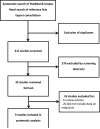Prognostic value of epicardial fat volume measurements by computed tomography: a systematic review of the literature
- PMID: 25925354
- PMCID: PMC4596752
- DOI: 10.1007/s00330-015-3765-5
Prognostic value of epicardial fat volume measurements by computed tomography: a systematic review of the literature
Abstract
Objectives: To perform a systematic review of the growing body of literature evaluating the prognostic value of epicardial fat volume (EFV) quantified by cross-sectional imaging.
Methods: Two independent reviewers performed systematic searches on both PubMed and Scopus using search terms developed with a medical librarian. Peer-reviewed articles were selected based on the inclusion of outcome data, utilization of epicardial fat volume and sufficient reporting for analysis.
Results: A total of 411 studies were evaluated with nine studies meeting the inclusion criteria. In all, the studies evaluated 10,252 patients. All nine studies were based on CT measurements. Seven studies evaluated the prognostic value of EFV unadjusted for calcium score, and six of these studies found a significant association between EFV and clinical outcomes. Seven studies evaluated the incremental value of EFV beyond calcium scoring, and six of these studies found a significant association.
Conclusions: The majority of studies suggest that EFV quantification is significantly associated with clinical outcomes and provides incremental prognostic value over coronary artery calcium scoring. Future research should use a binary cutoff of 125 mL for evaluation of EFV to provide consistency with other research.
Key points: • Epicardial fat volume (EFV) has prognostic value for adverse cardiac events • Establishment of standardized quantitative categories for EFV is needed • Quantification of EFV could improve risk assessment with calcium scoring.
Keywords: Cardiac computed tomography; Coronary artery calcium; Epicardial fat; Major adverse cardiac events; Prognostic value.
Figures
References
-
- Iacobellis G, Ribaudo MC, Assael F, et al. Echocardiographic epicardial adipose tissue is related to anthropometric and clinical parameters of metabolic syndrome: a new indicator of cardiovascular risk. J Clin Endocrinol Metab. 2003;88:5163–5168. - PubMed
-
- Kim BJ, Kim BS, Kang JH. Echocardiographic epicardial fat thickness is associated with arterial stiffness. Int J Cardiol. 2012 10.1016/j.ijcard.2012.06.013. - PubMed
-
- Nakanishi R, Rajani R, Cheng VY, et al. Increase in epicardial fat volume is associated with greater coronary artery calcification progression in subjects at intermediate risk by coronary calcium score: a serial study using non-contrast cardiac CT. Atherosclerosis. 2011;218:363–368. - PubMed
-
- Raggi P, Alakija P. Epicardial adipose tissue: A long-overlooked marker of risk of cardiovascular disease. Atherosclerosis. 2013 10.1016/j.atherosclerosis.2013.02.030. - PubMed
-
- Stojanovska J, Kazerooni EA, Sinno M, et al. Increased epicardial fat is independently associated with the presence and chronicity of atrial fibrillation and radiofrequency ablation outcome. Eur Radiol. 2015 10.1007/s00330-015-3643-1. - PubMed
Publication types
MeSH terms
Grants and funding
LinkOut - more resources
Full Text Sources
Other Literature Sources
Medical



